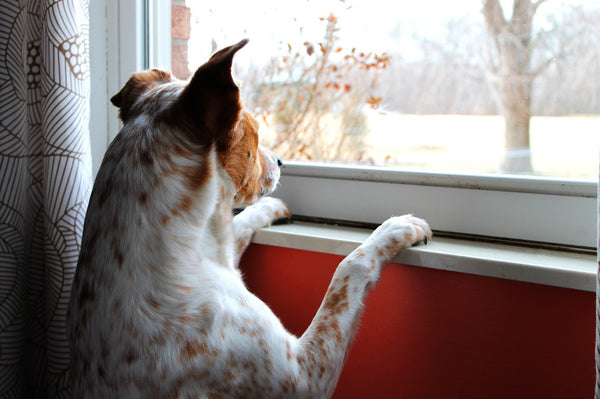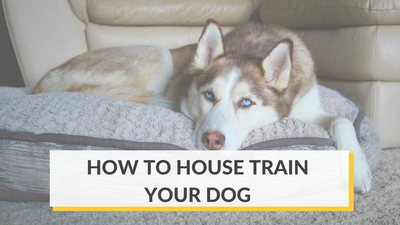Separation anxiety is a common issue for many dogs, and can be the root cause of a myriad of behavioral and health issues. Dogs who feel separation anxiety may tear up furniture, relieve themselves inside, get into trash, scratch or chew on doors, bark or howl all day long, or perform a number of other destructive behaviors. For you, this can range from inconvenient to extremely problematic. If you only have to clean up a few puddles here and there, that’s one thing, but if your upstairs neighbor complains to your landlord about your barking dog, that could present a serious problem.

And that’s not to mention the fact that your poor dog feels scared and anxious when you leave. Luckily, there are many ways that you can help your dog feel more comfortable when you go to work. With a little bit of time, you can usually eliminate many of these separation anxiety behaviors.
Start with Graduated Training
You want your pet to feel comfortable with you being gone, but to do that, you’ve got to convince him or her that you will always return. To do this, you can try a technique called graduated absences. First, simply command your dog to stay in one room, and leave that room – but not the house – for a short period of time. If your dog remains calm, waiting for you to call him, then try the same exercise exiting through a back or side door.

Slowly progress to longer absences, and then move on to exiting out the door you usually leave from. Once your dog can very calmly stay up to at least a few minutes, consider leaving them with a toy or dog puzzle while you run a very short errand or walk around the block. Be sure that you let your dog become totally relaxed between absences before you leave again.
Related Post: 5 Steps to Train Your Puppy to Be Home Alone
Also, it’s important to remain totally calm when you leave and when you come home during this graduated training. It’s okay to have a goodbye/hello ritual once your dog is trained to wait quietly for you – but right now, your goal is to make your absence and your presence seem like the same thing.

According to ASPCA, most dogs feel the most anxiety within the first 40 minutes of being alone. Once you have worked your way up to beyond 45 minutes, you can probably safely start increasing the absence times to much longer. If you do this gradual training over a period of about a month, doing multiple absences per day, you will probably see major changes in your dog’s behavior.
Give Your Dog Jobs
One reason that dogs often act destructively when left alone is that they are bored. Dogs were bred to perform tasks, and every breed – even mixed breed dogs – still feels a natural inclination towards their genetic “job”. Filling a dog toy with a treat that is difficult to get to can be a great way to keep your pet from losing interest. You can also try hiding treats or toys around the house (in safe areas) for your dog to find. This is especially great for smaller breeds, which were bred to find rodents hiding in small areas. Even toys that don’t involve an edible element are still great rewards for doggie hide and seek. Chewing and licking are both calming activities for pups, so chew toys work great for an anxious dog.
Related Post: Happy "Take Your Dog to Work Day”! Dos and Don'ts of Bringing Your Dog to Work
Consider Crate Training
For some dogs, having the big house to “guard” all by themselves, without their pack leader around, is very stressful. They may feel more comfortable in a smaller area, such as a designated room or a crate. Crate training can be beneficial because it gives dogs their own safe place to be. Imagine a crate like the dog version of a kid’s blanket fort, and you’ve got the right idea. Some dogs may not like being confined in quite so small a place, so be sure to watch for signs of stress when your dog is in their crate.
Activity Is Key
The absolute best thing you can do for a dog that cannot seem to stop being anxious is to provide plenty of physical activity when you are home. If you leave in the morning for work, then getting up for a half hour to an hour early for some serious playtime can help. Your dog will have a chance to burn off all their extra energy, and by the time you leave, your dog will be ready for a long nap. Once this pattern becomes routine, your dog will know that the day is for napping in preparation for the next morning’s big romp. And as a bonus, you’ll likely notice some improvements in your energy levels and concentration during the day!
Use a Pet Camera
If your dog seems to only respond to your voice, then a pet camera like Furbo is a great idea for separation anxiety. You can check in on your pet throughout the day, and remind them that you’ll be home soon. Furbo also sends an automatic notification if your dog is barking – so that you can calm them down and keep the neighbors from complaining. Check in and see that your dog looks stressed? Offer them a treat! Furbo will toss a treat into the air for them, just as if you were there playing. This pet camera even sees in the dark, so late shift employees aren’t unable to check on their dogs as well.
Related Post: 5 Types of Dog Owners Who Need A Dog Camera the Most

The best route may just be a combination of all five of these tips. But whatever you choose, be sure to stick to it. Dogs are creatures of routine and habit, so whatever you build into your day, they’ll soon get the rhythm and fall right into place. Before you know it, you’ll be coming home to a pup that has had a relaxing day of waiting for their favorite person to walk through the door.
















